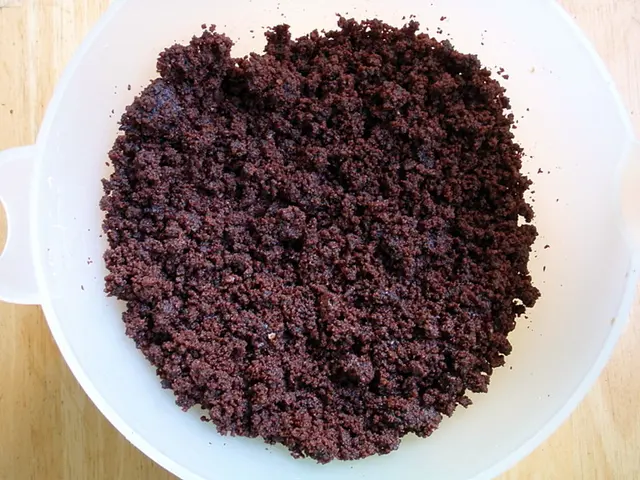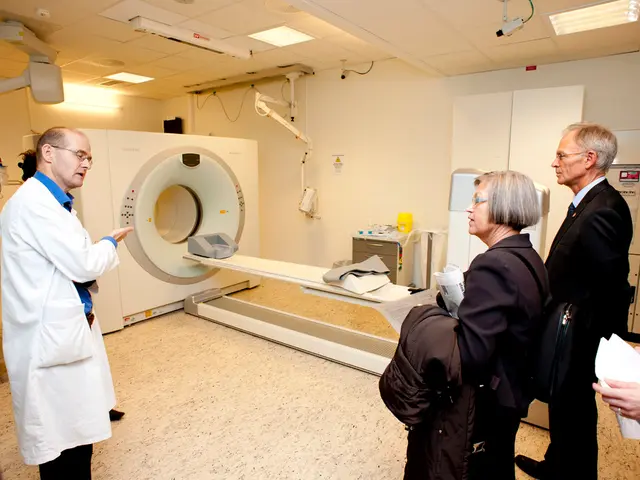Distinguishing Age Spots from Skin Cancer: Identifying the Differences
Chillin' with the Skin Facts:
No worries, my friend! Let's break down those age spots and skin cancer, 'cause knowing the difference can save your skin!
Spots vs. Skin Cancer:
Age spots and skin cancer can look alike at first glance, but don't sweat it - age spots are harmless and natural! Skin cancer, on the other hand, can be a real pain in the neck.
Age Spots (a.k.a. Solar Lentigines or Liver Spots):
Age spots are small, darker patches on your skin. They're usually flat and smooth and don't itch or feel rough. These bad boys develop because your body overproduces melanin to protect from sun damage[1]. They tend to appear on areas exposed to the sun, like your face, hands, shoulders, and feet.
Skin Cancer:
Skin cancer is a type of cancer that can grow in sun-exposed areas due to damage from UV radiation. This damage causes skin cells to mutate and grow abnormally[2]. Skin cancer isn't something to mess around with, so it's crucial to educate yourself on the signs and symptoms.
Common Types of Skin Cancer:
- Basal Cell Carcinoma: Small, pearly bumps that are pink, red, or white with a blue, black, or brown area.
- Squamous Cell Carcinoma: Red, scaly patches, lumps, or growths resembling warts.
- Melanoma: Identified using the ABCDE rule: asymmetrical shape, border irregularity, color variation, diameter greater than 6mm, and evolution over time[3].
What's the Deal with Actinic Keratosis?
Actinic keratosis might look like age spots, but it's a precancerous growth caused by excess UV radiation[4]. If left untreated, it could potentially turn into skin cancer, so keep those tomatoes off your skin and watch out for new or changing marks on your skin!
Symptoms:
Age Spots:
- flat and smooth
- yellow, brown, or gray
- clearly defined borders
- 1-10mm in size
- on sun-exposed areas like the:
- face
- hands
- shoulders
- feet
- arms
- back
These guys may fade in winter but become more pronounced in summer.
Skin Cancer:
- irregular shape
- blurred or ragged edges
- changing size, color, or shape
- multiple colors on the same spot
- pink, blue, purple, black, or brown coloring
- raised, red patches
- pale or yellow firm patches, similar to scars
- pain, itching, oozing, or bleeding
- crusty or scaly patches
- raised edges that lower in the middle
Actinic Keratosis:
- raised, rough, or scaly patches
- red, gray, pink, or skin-colored patches
- flat, scaly bumps that may look like age spots
- scaly, rough bumps that can appear in clusters similar to acne
- pale or scaly patches on the lips
- horn-like growths
When to Worry:
Keep a close eye on any new or changing marks on your skin and hit up a healthcare professional ASAP if you notice potential signs of skin cancer:
- a mark on the skin changes color, shape, size, or location
- a mark looks different from others on your skin
- a mark itches, crusts, scabs over, or bleeds and doesn't heal within 4 weeks
Diagnosis and Treatment:
Doctors can often diagnose age spots with a physical examination. If they're not sure, they might perform a skin biopsy to test for other conditions, like skin cancer. Treatment for age spots is optional, while skin cancer treatment will depend on several factors, like the type and stage of cancer and the individual's situation. Possible treatments include surgeries, radiation therapy, chemotherapy, immunotherapy, and systemic medication[5].
Stay informed, my friends, and let's keep the summer sunny while keeping our skin healthy!
[1] Mayo Clinic. (2020). Age Spots. Retrieved from https://www.mayoclinic.org/diseases-conditions/age-spots/symptoms-causes/syc-20372407[2] Skin Cancer Foundation. (2021). Skin Cancer Facts. Retrieved from https://www.skincancer.org/prevention/sun-protection/uv-index-guide[3] American Cancer Society. (2021). What Are the Signs of Skin Cancer? Retrieved from https://www.cancer.org/latest-news/signs-of-skin-cancer.html[4] AAD. (2021). Actinic Keratosis. Retrieved from https://www.aad.org/public/diseases/skin-cancer/actinic-keratosis[5] Cancer Treatment Centers of America. (2021). Skin Cancer: Types, Diagnosis, Treatment, and Prevention. Retrieved from https://www.cancercenter.com/cancer-types/skin-cancer/
- Seniors should be aware that melanoma, a type of skin cancer, can be identified using the ABCDE rule: asymmetrical shape, border irregularity, color variation, diameter greater than 6mm, and evolution over time.
- In oncology, dermatology, and medical-health discussions, it's crucial to educate oneself on skin-care, skin-conditions, and their symptoms to spot signs of skin cancer like Actinic Keratosis, Basal Cell Carcinoma, and Squamous Cell Carcinoma.
- Age spots, also known as Solar Lentigines or Liver Spots, are usually flat and smooth, appearing on areas exposed to the sun, and are harmless, unlike other skin cancers and Actinic Keratosis, a precancerous growth caused by excess UV radiation.
- Skin-care and health-and-wellness advocates emphasize that prevention is key in reducing the risk of skin cancer and other skin conditions like Actinic Keratosis.
- Science provides valuable information for early skin cancer detection, allowing individuals to take immediate action, such as visiting a healthcare professional, when suspicious marks or symptoms related to skin cancer, age spots, or Actinic Keratosis are noticed.








